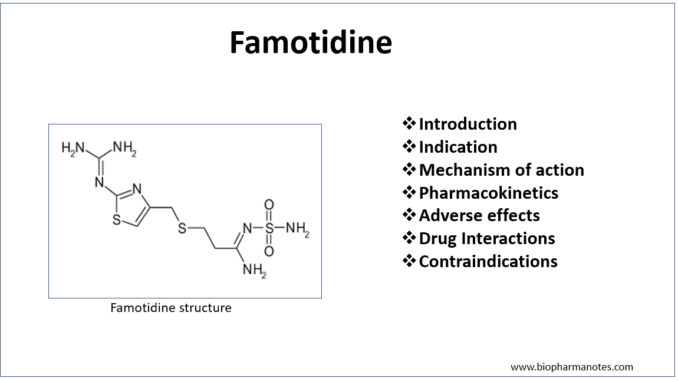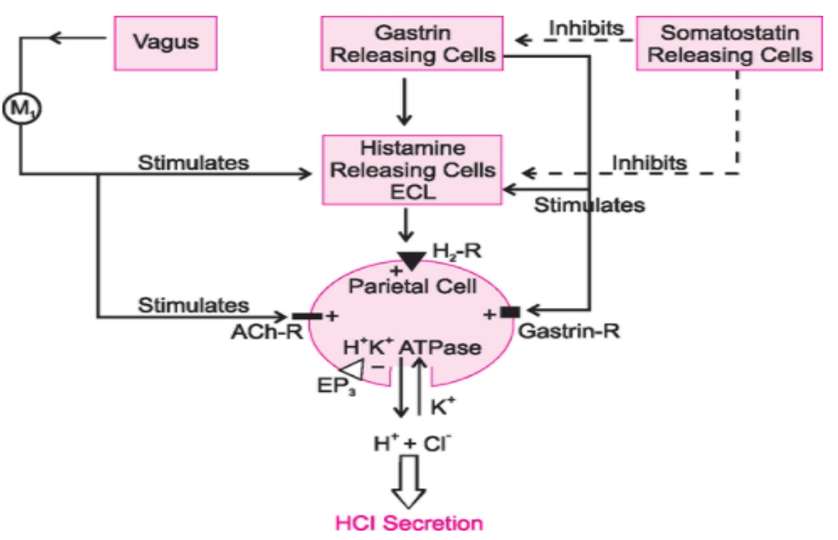
- Famotidine is histamine H2 receptor antagonist. H2 receptor antagonists are first class of drug used for treating peptic ulcer, but their use nowadays is surpassed by PPI (proton pump inhibitors). Other H2 receptor antagonist available in market are
- Cimetidine
- Nizatidine
- Roxatidine.
- Famotidine is available both as prescription and OTC (Over the Counter) medicine. It is FDA approved.
- It is 20-50 times more potent than cimetidine and 8 times more potent than ranitidine on weight basis.
Indications of famotidine
- In duodenal ulcer and gastric ulcer.
- In GERD (Gastro esophageal Reflux Disease).
- For treatment and prevention of heartburn due to gastroesophageal reflux in adults and pediatrics.
- Some off- label uses are symptomatic relief of gastritis, prevention of stress ulcer in critically ill patients and reducing gastrointestinal risk of NSAIDs.
Mechanism of action of famotidine

Figure- Mechanism involved in regulation of gastric acid secretion by parietal cells (ECL- Enterochromaffin cells, R- Receptor, EP-R- PG receptor for PGE2) Source- Pharmacology and Pharmacotherapeutics, 24th edition.
- To understand mechanism of action of famotidine, we should first understand mechanism of gastric acid secretion. The primary stimuli for gastric acid secretion include
- gastrin, released from antral G cells
- histamine released from oxyntic enterochromaffin-like cells
- acetylcholine released from antral and oxyntic neurons secondary to parasympathetic (vagal) stimulation.
- Other stimuli for gastric secretion include ghrelin and motilin.
- Histamine stimulates parietal cells by acting on H2 receptors. This is mediated by adenylate cyclase activation and generation of cyclic AMP (cAMP).
- Famotidine is a competitive H 2 receptor antagonist. Hence, it competes with histamine for H2 receptor present on basolateral membrane of parietal cells in stomach and cause competitive blockade of H2 receptors. Binding of histamine to H2 receptors is one of the factors responsible for promoting gastric acid secretion. Hence, blockade of H2 receptors helps to reduce secretion of gastric acid.
- It causes inhibition of both basal and nocturnal gastric acid secretion. It also reduces gastric volume, acidity and gastric secretion stimulated by food, caffeine or pentagastrin.
Pharmacokinetics of famotidine
- It is administered via oral, IM or IV route and is available in the form of gel capsules, chewable tablets, tablets or oral suspension. When oral or nasogastric routes cannot be used, it is given by continuous IV infusion or intermittent IV boluses.
- It is rapidly absorbed after oral administration. Peak plasma concentration is achieved within 1-3 hours. After IV administration of famotidine, therapeutic level is achieved immediately and is maintained for around 10-12 hours.
- It is metabolized in liver by cytochrome P450 enzymes. Its elimination half-life is around 2.5-3.5 hours. It is excreted by kidney. Around 70% of administered drug is excreted in unchanged form. Its half-life may increase in patients with decreased renal function and hence dosage adjustment is required.
Adverse effects
- It is generally well tolerated. some of its side effects include headache, dizziness, diarrhea, constipation and agitation.
- Some rare side effects on CNS are confusion, hallucination, slurred speech and delirium. It mostly occur after IV administration or in elderly patients.
Drug Interactions
- As it has low affinity for cytochrome P450 enzymes, its effect on metabolism of other drug is minimum. It can decrease metabolism of drugs like acetaminophen, capsaicin or caffeine.
- It can reduce effectiveness of drugs which require acidic environment of absorption like ketoconazole. Concurrent administration with cimetidine can decrease its excretion.
Contraindications
- Contraindicated in patients with serious hypersensitivity to famotidine or with history of hypersensitivity to cimetidine.
References
- https://www.ncbi.nlm.nih.gov/books/NBK534778/
- https://go.drugbank.com/drugs/DB00927
- Chremos AN et al. Clinical pharmacology of famotidine: a summary. J Clin Gastroenterol. 1987; 9 Suppl 2: 7-12.
- Langtry et al. Famotidine. An updated review of its pharmacodynamic and pharmacokinetic properties, and therapeutic use in peptic ulcer disease and other allied diseases. Drugs. 1989 Oct; 38(4): 551-90.
- Lippincott Illustrated Reviews Pharmacology, 6th edition.
- Pharmacology and pharmacotherapeutics. 24th edition.
- Goodman and Gillman Manual of Pharmacology and Therapeutics.
- Essentials of Medical Pharmacology. 7th edition.